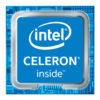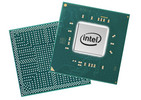Intel Celeron N5105 vs Intel Celeron N4020 vs Intel Celeron N5095
Intel Celeron N5105
► remove from comparison
The Intel Celeron N5105 is a quad-core SoC of the Jasper Lake series that is primarily intended for inexpensive desktops and was announced in early 2021. The four Tremont CPU cores clock between 2 and 2.9 GHz (single core Burst) and offer no HyperThreading (SMT). The N5105 uses 1.5 MB L2 and 4 MB L3 cache. The chip is manufactured in 10nm at Intel (most likely in the same process as Ice Lake).
CPU Architecture
The processor architecture is called Tremont and a complete redesign compared to the old Golmont Plus cores in the predecessor. According to Intel, the single thread performance of a core could be improved by 30% on average (10 - 80% in all tests of SPECint and SPECfp).
Features
In addition to the quad-core CPU block, the SoC integrates a 24 EU Intel UHD Graphics GPU clocked from 450 - 800 MHz and a LPDDR4(x) dual channel memory controller (up to 16 GB and 2933 MHz). The chip now also partly integrates Wi-Fi 6 (Gig+), 8 PCIe 3.0 lanes, 14 USB 2.0/ 3.2 ports and two SATA 6.0 ports. The package got bigger and measures 35 x 24 mm (compared to 25 x 24 mm for the N5030 e.g.). The SoC is directly soldered to the mainboard (BGA) and can't be easily replaced.
Performance
The average N5105 in our database is in the same league as the Core i3-1005G1 and the Ryzen 3 3250U, as far as multi-thread benchmark scores are concerned. Your mileage may vary depending on how high the CPU power limits are.
Power Consumption
Similar to the predecessor, Intel specifies the TDP with 10 Watts (mobile and lower clocked N5100 6W). The chip can therefore be cooled passively in theory, but SKUs with fans are possible as well.
Intel Celeron N4020
► remove from comparison
The Intel Celeron N4020 is a slow dual-core processor (SoC) of the Gemini Lake refresh product family; as such, it is designed for use in laptops and mini-PCs of the most affordable flavor. The Celeron was launched in Q4 2019. Its CPU cores run at 1.1 GHz to 2.8 GHz, the latter being a moderate 200 MHz upgrade over the preceding N4000 chip. Other key specs include a DDR4/LPDDR4 memory controller (up to 2,400 MHz and up to 8 GB, with independent reports claiming as much as 32 GB will work just fine) and an integrated UHD 600 graphics adapter.
Architecture & Features
Just like Apollo Lake family products, the ever-popular N3350 included, the N4020 is manufactured on a really old, as of late 2023, 14 nm process. What makes the newer Celerons different are the slightly improved processor cores with double the L2 cache and also, somewhat counterintuitively, a reduction in physical size.
The Goldmont Plus microarchitecture is not much different from what was used in Gemini Lake processors like the N4000. A relatively large 4 MB L2 cache features prominently on the rather short list of N4020's strong sides, allowing for a marginal increase in performance-per-MHz figures compared to processors of previous generations. Still, Gemini Lake refresh processors are a clear step down from Core i3/i5/i7/i9 series processors, both in performance and in features.
The N4020 has six PCI-Express 2.0 lanes at its disposal. While very few N4020-based SBCs, nettops and laptops feature an NVMe M.2 slot, you can use an NVMe SSD as a boot drive with this processor (read/write rates will be limited to 2 GB/s, though). Furthermore, partial Wi-Fi 5 support is built into the CPU. The Celeron also supports up to eight USB 3.0 ports and two SATA III storage devices.
Please note this is not a user-replaceable CPU. They solder it straight to the motherboard for good (BGA1090 socket interface).
Performance
While slightly faster than the outgoing Celeron N4000, the average N4020 in our extensive database only just manages to match the N6211, as far as multi-thread performance is concerned. These three chips deliver multi-thread CB R15, CB R20 and CB R23 scores that are so low, they lag behind a single-thread score of any half-decent CPU such as an i5-1135G7. In other words, these Celeron N chips are good enough for basic tasks only such as word processing and Web browsing with two or three tabs open at a time.
The Celeron N4120, a quad-core chip with a similar name, has little trouble leaving the N4020 behind in most workloads - which is not to say it is a fast CPU.
Jacking the long-term power limit value up to something like 9 W will help improve system responsiveness noticeably.
Graphics
The UHD Graphics 600 is based on Intel's Generation 9 architecture, much like the HD Graphics 520 or the UHD Graphics 615 or other widespread Intel iGPUs found in Core i3/i5/i7/i9 processors of generations six to ten.
Just like the HD Graphics 500, the UHD Graphics 600 is DX12 compatible. The iGPU's 12 EUs can run at up to 650 MHz. The Iris Plus G7 iGPU that certain 10th Gen Ice Lake processors have packs 64 EUs, for reference. As a low-end solution, UHD Graphics 600 will let you play some seriously old titles, but that's about as far as its talents go.
Perhaps more importantly, this graphics solution can drive up to 3 monitors with resolutions as high as 4096x2160@60. Furthermore, it will have no trouble HW-decoding AVC, HEVC and VP9-encoded videos. The newer AV1 codec will be decoded via software, with the limited CPU horsepower imposing a limit on video resolutions that can be played back without stuttering. 1080p60 videos are out of reach while 720p25 videos run fine, to give you an example.
Power consumption
The low 6 W TDP (also known as the long-term Power Limit) makes it easy for laptop makers to ditch the fan. Performance sustainability will be poor unless the long-term Power Limit is set to a value higher than the default 6 W and a fan is available to aid in heat dissipation.
The Celeron N4020 is built with one of the old 14 nm Intel processes for poor, as of mid 2023, energy efficiency.
Intel Celeron N5095
► remove from comparison
The Intel Celeron N5095 is a quad-core SoC of the Jasper Lake product family designed for use in affordable SFF desktops and laptops. The Celeron was announced in early 2021. It features four Tremont CPU cores running at 2 GHz (base clock speed) Boosting up to 2.9 GHz (single-core Boost) with 1.5 MB of L2 and 4 MB of L3 cache but no thread-doubling Hyper-Threading technology. This processor is manufactured on Intel's first-gen 10 nm process to be not unlike the Ice Lake-U Core-series processors. The faster Celeron N5105 is notable for being more energy efficient (10 W TDP vs N5095's 15 W) yet featuring a faster iGPU model (24 EU UHD Graphics versus 16 EU UHD Graphics, with a higher clock rate to boot).
Architecture
Tremont architecture brings many improvements over the outgoing Goldmont architecture we know from Pentium N5030 and so many other N-class CPUs. According to Intel, the new architecture brings a 30% boost in single thread performance (+10% to +80% in SPECint and SPECfp depending on the test).
While the older N-class Celerons and Pentiums had to be content with up to 8 GB of DDR4-2400 RAM, Celeron N5095 is officially compatible with up to 16 GB of dual-channel DDR4-2933 or quad-channel LPDDR4x-2933 memory. Wi-Fi 6 (Gig+) support is partially baked into the chip. The Celeron supports up to 8 PCI-Express 3.0 lanes, up to 14 USB 3.2 ports and up to two SATA III ports. Four PCI-Express 3.0 lanes allow for read/write rates of up to 3.9 GB/s, provided a suitably fast NVMe SSD is used.
Jasper Lake processor package is larger compared to what Gemini Lake models had (35 x 24 mm vs. 25 x 24 mm). Please note that the Celeron gets soldered on to the motherboard (BGA1338 socket interface) and is thus not user-replaceable.
Performance
The average N5095 in our database matches the Core i3-10110U, Core i3-1005G1, Celeron N5105 and also the Ryzen 3 3200U, as far as multi-thread benchmark scores are concerned.
Even if the cooling system is great and the Power Limits are high as the sky, some slight architectural improvements together with the updated manufacturing node and higher-than-usual wattage of the Celeron are not nearly enough to let it compete with modern Core and Ryzen-series processors. It's a good option for basic day-to-day tasks, but anything beyond that will be a struggle.
Graphics
The CPU features the DirectX 12-capable 16 EU UHD Graphics iGPU running at 450 MHz to 750 MHz. The graphics adapter is capable of driving up to 3 displays with resolutions up to 4096x2160@60; it will happily decode HEVC, AVC, VP9, MPEG-2 and other popular video codecs. The latest AV1 codec is not supported, though. (You can still play such a video but it will be software-decoded rather than hardware-decoded which puts a hard limit on the watchable resolution as the CPU cores are not very fast here.)
This is not a gaming GPU by any stretch of imagination. It is just as fast as an HD Graphics 515; it will let you play the least demanding titles (like Dota 2 Reborn) provided you are OK with 720p resolution and lowest quality preset possible.
Power consumption
Most N-class Celerons and Pentiums have a 6 W TDP (also known as the long-term Power Limit). The Celeron N5095 on the other hand has a 15 Watt TDP to mimic much faster U-class Core i3/i5/i7 processors. This basically means that passively cooled designs are out of the question with this chip.
This Intel processor is manufactured on Intel's first-gen or second-gen 10 nm process [no precise data available] for OK, as of late 2022, energy efficiency.
| Model | Intel Celeron N5105 | Intel Celeron N4020 | Intel Celeron N5095 | ||||||||||||||||||||||||||||||||||||||||||||||||||||||||||||||||||||||||||||||||
| Series | Intel Jasper Lake | Intel Gemini Lake | Intel Jasper Lake | ||||||||||||||||||||||||||||||||||||||||||||||||||||||||||||||||||||||||||||||||
| Codename | Jasper Lake | Gemini Lake refresh | Jasper Lake | ||||||||||||||||||||||||||||||||||||||||||||||||||||||||||||||||||||||||||||||||
| Series: Jasper Lake Jasper Lake |
|
|
| ||||||||||||||||||||||||||||||||||||||||||||||||||||||||||||||||||||||||||||||||
| Clock | 2000 - 2900 MHz | 1100 - 2800 MHz | 2000 - 2900 MHz | ||||||||||||||||||||||||||||||||||||||||||||||||||||||||||||||||||||||||||||||||
| L2 Cache | 1.5 MB | 4 MB | 1.5 MB | ||||||||||||||||||||||||||||||||||||||||||||||||||||||||||||||||||||||||||||||||
| L3 Cache | 4 MB | 4 MB | |||||||||||||||||||||||||||||||||||||||||||||||||||||||||||||||||||||||||||||||||
| Cores / Threads | 4 / 4 | 2 / 2 | 4 / 4 | ||||||||||||||||||||||||||||||||||||||||||||||||||||||||||||||||||||||||||||||||
| TDP | 10 Watt | 6 Watt | 15 Watt | ||||||||||||||||||||||||||||||||||||||||||||||||||||||||||||||||||||||||||||||||
| Technology | 10 nm | 14 nm | 10 nm | ||||||||||||||||||||||||||||||||||||||||||||||||||||||||||||||||||||||||||||||||
| max. Temp. | 105 °C | 105 °C | |||||||||||||||||||||||||||||||||||||||||||||||||||||||||||||||||||||||||||||||||
| Socket | BGA1338 | BGA1090 | BGA1338 | ||||||||||||||||||||||||||||||||||||||||||||||||||||||||||||||||||||||||||||||||
| Features | DDR4-2933/LPDDR4x-2933 RAM, PCIe 3, GNA, MMX, SSE, SSE2, SSE3, SSSE3, SSE4.1, SSE4.2, VMX, SMEP, SMAP, EIST, TM1, TM2, Turbo, AES-NI, RDRAND, RDSEED, SHA | DDR4-2400/LPDDR4-2400 RAM, PCIe 2, MMX, SSE, SSE2, SSE3, SSSE3, SSE4.1, SSE4.2, VMX, SMEP, SMAP, MPX, EIST, TM1, TM2, Turbo, AES-NI, RDRAND, RDSEED, SHA, SGX | DDR4-2933/LPDDR4x-2933 RAM, PCIe 3, GNA, MMX, SSE, SSE2, SSE3, SSSE3, SSE4.1, SSE4.2, VMX, SMEP, SMAP, EIST, TM1, TM2, Turbo, SST, AES-NI, RDRAND, RDSEED, SHA | ||||||||||||||||||||||||||||||||||||||||||||||||||||||||||||||||||||||||||||||||
| iGPU | Intel UHD Graphics (Jasper Lake 24 EU) (450 - 800 MHz) | Intel UHD Graphics 600 (200 - 650 MHz) | Intel UHD Graphics (Jasper Lake 16 EU) (450 - 750 MHz) | ||||||||||||||||||||||||||||||||||||||||||||||||||||||||||||||||||||||||||||||||
| Architecture | x86 | x86 | x86 | ||||||||||||||||||||||||||||||||||||||||||||||||||||||||||||||||||||||||||||||||
| Announced | |||||||||||||||||||||||||||||||||||||||||||||||||||||||||||||||||||||||||||||||||||
| Manufacturer | ark.intel.com | ark.intel.com | ark.intel.com | ||||||||||||||||||||||||||||||||||||||||||||||||||||||||||||||||||||||||||||||||
| TDP Turbo PL2 | 15 Watt |


 Deutsch
Deutsch English
English Español
Español Français
Français Italiano
Italiano Nederlands
Nederlands Polski
Polski Português
Português Русский
Русский Türkçe
Türkçe Svenska
Svenska Chinese
Chinese Magyar
Magyar
